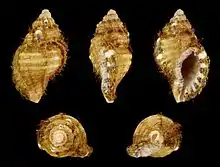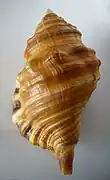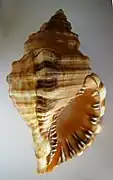Monoplex parthenopeus
Monoplex parthenopeus,[3][4] common name the giant triton or giant hairy triton, is a species of sea snail, a marine gastropod mollusk in the family Cymatiidae.[2] It preys on other molluscs.
| Monoplex parthenopeus Temporal range: | |
|---|---|
 | |
| Apertural view of Monoplex parthenopeus | |
| Scientific classification | |
| Domain: | Eukaryota |
| Kingdom: | Animalia |
| Phylum: | Mollusca |
| Class: | Gastropoda |
| Subclass: | Caenogastropoda |
| Order: | Littorinimorpha |
| Family: | Cymatiidae |
| Genus: | Monoplex |
| Species: | M. parthenopeus |
| Binomial name | |
| Monoplex parthenopeus (Salis-Marschlins, 1793) | |
| Synonyms[2] | |
| |
Fossil records
This species have been recorded as fossils from the Miocene to the Quaternary (from 15.97 to 0.0 million years ago).[5]
Life cycle
Hairy tritons are notable for having particularly long planktonic periods. The veliger larvae remain in the plankton for nearly 300 days, dispersing as far as 4000 km.[8] This is the longest known larval duration and dispersal distance of any marine invertebrate which occurs along the west coast of North America.[9]
Gallery
 A shell of Monoplex parthenopeus with periostracum removed
A shell of Monoplex parthenopeus with periostracum removed Same shell, apertural view
Same shell, apertural view.jpg.webp) Apertural view of Monoplex parthenopeus echo (Kuroda & Habe in Kira, 1961) with operculum and periostracum attached
Apertural view of Monoplex parthenopeus echo (Kuroda & Habe in Kira, 1961) with operculum and periostracum attached Fossil shell of Monoplex parthenopeus from Pliocene of Italy
Fossil shell of Monoplex parthenopeus from Pliocene of Italy
References
- Mollusc Specialist Group (2000). "Cymatium parthenopaeum". IUCN Red List of Threatened Species. 2000: e.T6069A12386021. doi:10.2305/IUCN.UK.2000.RLTS.T6069A12386021.en.
- Monoplex parthenopeus (Salis-Marschlins, 1793). Retrieved through: World Register of Marine Species on 6 December 2018.
- "Cymatium parthenopeum (Salis, 1793)", CLEMAM, accessed 18 February 2011.
- "Cymatium parthenopeum (von Salis, 1793)". Malacolog Version 4.1.1. A Database of Western Atlantic Marine Mollusca. accessed 17 February 2011.
- Fossilworks
- Powell A. W. B., New Zealand Mollusca, William Collins Publishers Ltd, Auckland, New Zealand 1979 ISBN 0-00-216906-1
- Welch J. J. (2010). "The "Island Rule" and Deep-Sea Gastropods: Re-Examining the Evidence". PLOS One 5(1): e8776. doi:10.1371/journal.pone.0008776.
- Scheltema, R. S. 1971. Larval dispersal as a means of genetic exchange between geographically separated populations of shoalwater benthic marine gastropods. Biological Bulletin 140:284–322.
- AL Shanks, BA Grantham, MH Carr (2003) Propagule dispersal distance and the size and spacing of marine reserves. Ecological Applications, 13, S159-S169.
- Salis Marschlins C. U. von (1793). Reisen in verschieden Provinzen den Königreischs Neapel. Zurich and Leipzig, Ziegler Vol. I: pp. 442 + 10 pl.
- Beu, A. G. (1970). The Mollusca of the subgenus Monoplex (family Cymatiidae). Transactions of the Royal Society of New Zealand, Biological Sciences 11 (17): 225-237
- Morton B. & Morton JE. (1983). The sea shore ecology of Hong Kong. Hong Kong: Hong Kong University Press
- Gofas, S.; Afonso, J.P.; Brandào, M. (Ed.). (S.a.). Conchas e Moluscos de Angola = Coquillages et Mollusques d'Angola. [Shells and molluscs of Angola]. Universidade Agostinho / Elf Aquitaine Angola: Angola. 140 pp
- Gofas, S.; Le Renard, J.; Bouchet, P. (2001). Mollusca, in: Costello, M.J. et al. (Ed.) (2001). European register of marine species: a check-list of the marine species in Europe and a bibliography of guides to their identification. Collection Patrimoines Naturels, 50: pp. 180–213
- Rolán E., 2005. Malacological Fauna From The Cape Verde Archipelago. Part 1, Polyplacophora and Gastropoda.
- Rosenberg, G., F. Moretzsohn, and E. F. García. 2009. Gastropoda (Mollusca) of the Gulf of Mexico, Pp. 579–699 in Felder, D.L. and D.K. Camp (eds.), Gulf of Mexico–Origins, Waters, and Biota. Biodiversity. Texas A&M Press, College Station, Texas.
- Beu A.G. 2010 [August]. Neogene tonnoidean gastropods of tropical and South America: contributions to the Dominican Republic and Panama Paleontology Projects and uplift of the Central American Isthmus. Bulletins of American Paleontology 377-378: 550 pp, 79 pls.
External links
- Pilsbry, H. A. (1945). New Floridian marine mollusks. The Nautilus. 59(2): 59-60
- Perry, G. (1811). Conchology, or the natural history of shells: containing a new arrangement of the genera and species, illustrated by coloured engravings executed from the natural specimens, and including the latest discoveries. 4 pp., 61 plates. London
- Born, I. Von. (1778). Index rerum naturalium Musei Cæsarei Vindobonensis. Pars I.ma. Testacea. Verzeichniß der natürlichen Seltenheiten des k. k. Naturalien Cabinets zu Wien. Erster Theil. Schalthiere; Vindobonae (Vienna); (Kraus)
- Risso, A. (1826-1827). Histoire naturelle des principales productions de l'Europe Méridionale et particulièrement de celles des environs de Nice et des Alpes Maritimes. Paris, F.G. Levrault. 3(XVI): 1-480, 14 pls.
- Hutton, F. W. (1873). Catalogue of the marine Mollusca of New Zealand with diagnoses of the species. Didsbury, Wellington. xx + 116 pp.
- Orbigny A. d'. (1841-1853). Mollusques. In: R. de la Sagra (ed.). Histoire physique, politique et naturelle de l'Ile de Cuba. Arthus Bertrand, Paris. Vol 1
- Gould, A. A. (1849). Descriptions of new species of shells, brought home by the U. S. Exploring Expedition. Proceedings of the Boston Society of Natural History. 3: 83-85, 89-92, 106-108, 118-121
- Gould, A. A. (1860). Descriptions of new shells collected by the United States North Pacific Exploring Expedition. Proceedings of the Boston Society of Natural History. 7: 323-336
- Smith, E. A. (1890). Report on the marine molluscan fauna of the island of St. Helena. Proceedings of the Zoological Society of London. (1890): 247-317, pls 21-24
- Bellardi, L. (1873). I molluschi dei terreni terziarii del Piemonte e della Liguria. Parte I. Cephalopoda, Pteropoda, Heteropoda. Gasteropoda (Muricidae et Tritonidae). Stamperia Reale, Torino, 264 pp., 15 pl.
- Drawing of the shell
- Photos of Monoplex parthenopeus on Sealife Collection
Wikimedia Commons has media related to Monoplex parthenopeus.
This article is issued from Wikipedia. The text is licensed under Creative Commons - Attribution - Sharealike. Additional terms may apply for the media files.
